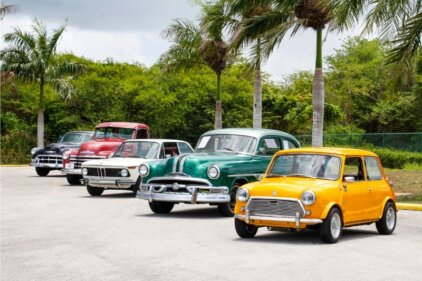The classic car restoration industry in the UK has experienced a remarkable surge in popularity, attracting a diverse array of enthusiasts, collectors, and entrepreneurs. From the rolling hills of the Cotswolds to the bustling streets of London, the country has become a hub for those seeking to breathe new life into these timeless masterpieces.
The history and significance of classic cars
Classic cars hold a special place in the hearts of many, serving as a tangible connection to the past and a testament to the ingenuity and craftsmanship of bygone eras. These vehicles, with their distinctive designs, evocative styling, and rich histories, have the power to transport us to a bygone era, evoking a sense of nostalgia and wonder.
In the UK, the appreciation for classic cars has deep roots, tracing back to the early 20th century when the country’s automotive industry was at the forefront of global innovation. From the iconic Morris Minor to the sleek Jaguar E-Type, these cars have become symbols of British engineering prowess and cultural identity.
The rising popularity of classic car restoration in the UK
Over the past decade, we’ve witnessed a remarkable resurgence in the popularity of classic car restoration in the UK. Driven by a growing appreciation for automotive heritage, a desire to preserve our cultural legacy, and the allure of owning a unique, one-of-a-kind vehicle, the demand for classic car restoration services has skyrocketed.
Across the country, enthusiasts and collectors have been scouring the nation, unearthing hidden gems and forgotten relics, eager to breathe new life into these automotive treasures. The restoration process has become a labour of love, with meticulous attention to detail and a deep respect for the original craftsmanship.
Challenges and considerations in classic car restoration
Restoring a classic car is no easy feat, as it requires a unique blend of technical expertise, historical knowledge, and a keen eye for detail. From sourcing rare and authentic parts to navigating the complex web of regulations and legalities, the restoration journey is filled with both challenges and rewards.
One of the primary hurdles faced by classic car enthusiasts is the scarcity of original components and the need to source replacement parts that seamlessly integrate with the vehicle’s original design. This requires a deep understanding of the car’s history, as well as a network of trusted suppliers and specialists who can provide the necessary resources.
Additionally, the restoration process itself can be a delicate and time-consuming endeavour, as each step must be executed with the utmost care to preserve the car’s integrity and authenticity. From stripping the vehicle down to its bare bones to meticulously rebuilding and refinishing every component, the restoration journey is a true test of patience and dedication.
Essential steps and processes in classic car restoration
Restoring a classic car is a multifaceted process that requires a systematic approach. Here’s a breakdown of the essential steps involved:
- Acquisition and Inspection: The first step is to acquire the classic car, which often involves scouring the market for the right vehicle. Once the car is in your possession, a thorough inspection is conducted to assess the overall condition, identify any issues, and develop a comprehensive restoration plan.
- Disassembly and Documentation: With the car’s condition assessed, the next step is to carefully disassemble the vehicle, documenting every step along the way. This meticulous process ensures that the car can be reassembled accurately and efficiently.
- Repair and Restoration: The heart of the restoration process lies in the repair and restoration of the car’s various components. This may involve rebuilding the engine, refurbishing the interior, and restoring the bodywork to its former glory.
- Sourcing and Replacement: Obtaining authentic and high-quality replacement parts is crucial to maintaining the car’s integrity. This often requires extensive research, networking, and sometimes even custom fabrication.
- Reassembly and Finishing Touches: With the car’s components repaired and restored, the final step is to carefully reassemble the vehicle, ensuring that every element is in perfect working order. The finishing touches, such as paint, upholstery, and detailing, are then applied to bring the car back to its showroom-ready condition.
Throughout this process, attention to detail and a deep respect for the car’s history are paramount, as the goal is to not only restore the vehicle but to preserve its authenticity and character.
Tips for finding and purchasing classic cars for restoration
Embarking on a classic car restoration journey often begins with the search for the right vehicle. Here are some valuable tips to help you navigate the process of finding and purchasing a classic car for restoration:
- Networking and Research: Tap into the vibrant classic car community, both online and offline, to uncover hidden gems and connect with trusted sellers. Attend car shows, join enthusiast forums, and network with fellow collectors to expand your search.
- Inspection and Evaluation: When evaluating a potential restoration project, it’s crucial to conduct a thorough inspection. This includes assessing the car’s overall condition, identifying any major issues, and determining the feasibility and cost of the restoration.
- Provenance and Documentation: Establishing the car’s provenance, or ownership history, can provide valuable insights into its past and help you make an informed purchase decision. Seek out detailed documentation, such as service records and previous restoration work, to ensure you’re investing in a car with a well-documented history.
- Budget and Financing: Restoring a classic car can be a significant financial investment, so it’s essential to establish a realistic budget and explore financing options, such as classic car loans or restoration-specific financing.
- Legal and Regulatory Considerations: Familiarize yourself with the legal and regulatory requirements for owning and restoring classic cars in the UK, as there may be specific rules and regulations to navigate.
Tools and equipment needed for classic car restoration
Restoring a classic car requires a comprehensive toolkit and specialized equipment. Here’s a list of some of the essential tools and equipment needed for a successful restoration project:
- Automotive Tools: A comprehensive set of mechanic’s tools, including wrenches, sockets, pliers, and specialized tools for engine, transmission, and suspension work.
- Bodywork and Painting Tools: Tools for bodywork repair, such as grinders, sanders, body hammers, and paint spraying equipment.
- Welding and Fabrication Tools: Welding equipment, including a MIG or TIG welder, for fabricating custom parts or repairing bodywork.
- Diagnostic and Testing Equipment: Diagnostic tools, such as multimeters and engine analyzers, to ensure proper functioning of the vehicle’s systems.
- Specialty Tools: Specific tools for tasks like engine rebuilding, interior restoration, and electrical work, depending on the make and model of the classic car.
- Workshop Essentials: A well-equipped workshop with essential equipment like a hydraulic lift, air compressor, and workbenches to facilitate the restoration process.
Investing in the right tools and equipment is crucial to ensuring a successful and efficient classic car restoration project.
Common classic car restoration projects and success stories
The classic car restoration scene in the UK is filled with inspiring success stories, each one a testament to the dedication, skill, and passion of the individuals involved. Here are a few examples of common restoration projects and the remarkable transformations they have undergone:
- Jaguar E-Type Restoration: The iconic Jaguar E-Type, often referred to as the “most beautiful car ever made,” has been a popular choice for restoration enthusiasts. From painstakingly rebuilding the car’s sleek bodywork to meticulously restoring the powerful engine, these restoration projects have breathed new life into these automotive legends.
- Morris Minor Revitalization: The charming and quintessentially British Morris Minor has been a beloved classic car for decades. Restorers have taken on the challenge of reviving these compact icons, often focusing on preserving the car’s original character while incorporating modern upgrades to enhance performance and reliability.
- Triumph TR6 Transformation: The Triumph TR6 is a classic sports car that has captured the hearts of enthusiasts worldwide. Restoration projects have involved everything from rebuilding the car’s suspension and brakes to meticulously restoring the interior and exterior to their former glory.
- Austin-Healey Rebirth: The Austin-Healey, with its distinctive styling and spirited driving dynamics, has been a long-standing favourite among classic car enthusiasts. Restoration projects have focused on preserving the car’s iconic design while addressing any mechanical or cosmetic issues to ensure a truly authentic driving experience.
These are just a few examples of the remarkable transformations that have taken place within the classic car restoration scene in the UK. Each project is a testament to the skill, dedication, and passion of the individuals who have breathed new life into these automotive icons.
Classic car restoration services and professionals in the UK
The UK’s classic car restoration industry is home to a wealth of talented professionals and specialized services, catering to the diverse needs of enthusiasts and collectors. From small, family-owned workshops to large-scale restoration facilities, the country boasts a thriving ecosystem of experts dedicated to preserving and reviving these automotive treasures.
One of the key advantages of the UK’s classic car restoration scene is the depth of expertise and the availability of specialized services. Whether you’re in need of a complete ground-up restoration or require targeted repairs and refurbishments, you can find a wide range of professionals and service providers to cater to your needs.
These restoration experts often possess a deep understanding of the unique challenges and considerations involved in classic car restoration, drawing on their years of experience and a vast network of suppliers and resources. From engine rebuilding and bodywork repair to interior refurbishment and custom fabrication, these professionals are equipped to handle every aspect of the restoration process.
Additionally, the UK is home to a thriving community of classic car enthusiasts, collectors, and clubs, providing a valuable support network for those embarking on restoration projects. These groups often offer guidance, resources, and opportunities for collaboration, further enriching the classic car restoration experience.
Conclusion: Embracing the beauty and rewards of classic car restoration in the UK
As We reflect on the vibrant and thriving classic car restoration scene in the UK, We’re filled with a profound sense of appreciation and excitement. These automotive icons, with their timeless designs and rich histories, have the power to captivate and inspire us, reminding us of the ingenuity and craftsmanship that have shaped the automotive landscape.
Through the dedicated efforts of restoration enthusiasts, collectors, and professionals, the UK has emerged as a hub for the preservation and revitalization of these automotive treasures. From the rolling hills of the Cotswolds to the bustling streets of London, the country has become a mecca for those seeking to breathe new life into these timeless masterpieces.





